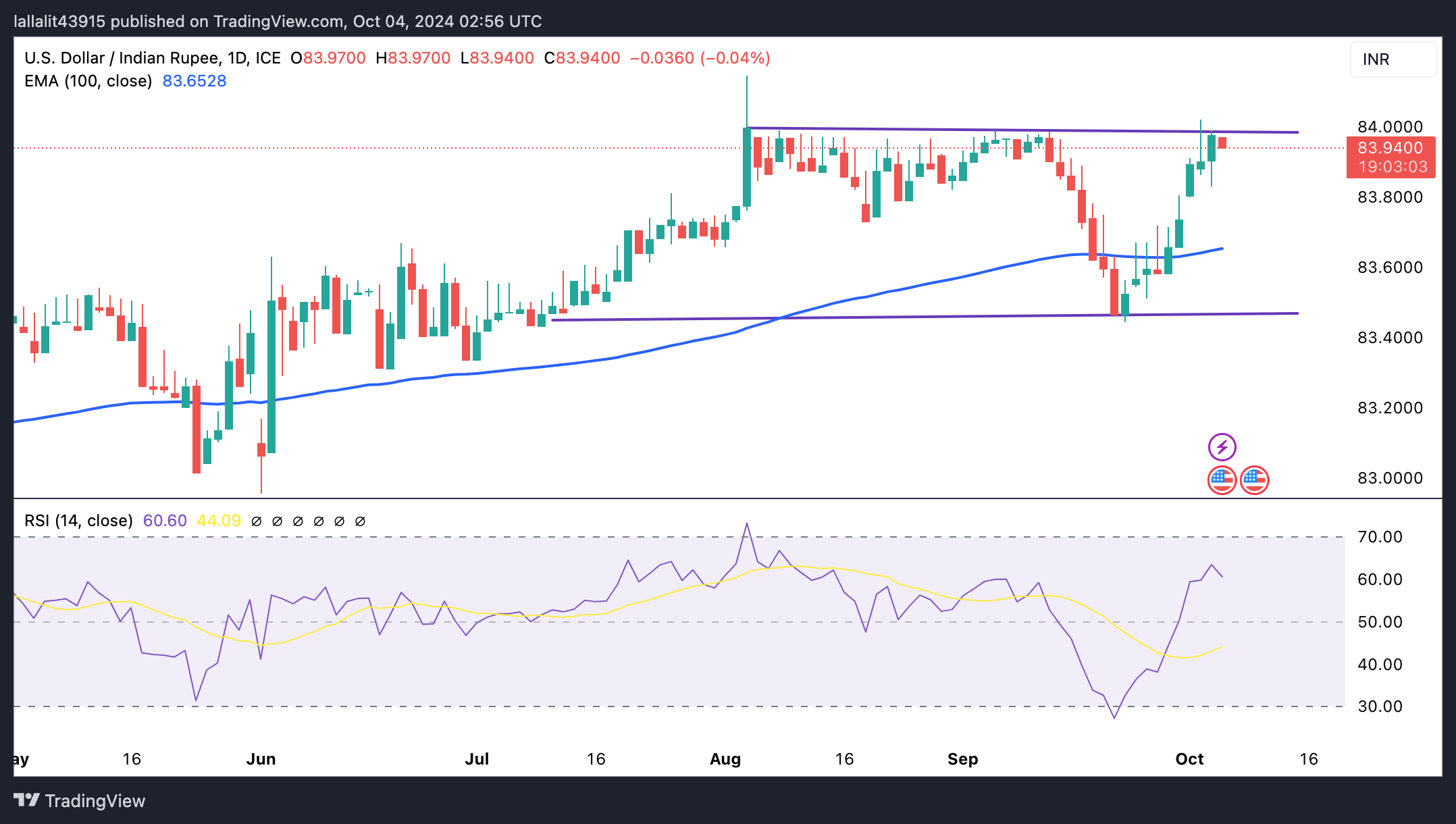- Indian Rupee holds positive ground in Friday’s early European session.
- The Indian HSBC Services PMI came in at 57.7 in September vs. 60.9 prior, weaker than expected.
- Higher crude oil prices and Foreign Portfolio Investors (FPI) outflows weigh on the INR.
- Investors await the US employment data, which is due later on Friday.
The Indian Rupee (INR) recovers some lost ground on Friday. The rise in crude oil prices amid escalating geopolitical tensions in the Middle East, the significant outflow from domestic equities and regional currency downtrends could undermine the INR.
The latest data released on Friday showed that the HSBC India Services Purchasing Managers Index (PMI) declined to 57.7 in September from 60.9 in August, below the market consensus of 58.9. This figure registered the lowest level in 10 months. The local currency remains strong against the USD despite the downbeat Services PMI report.
Looking ahead, the US employment data for September will take center stage, including Nonfarm Payrolls (NFP) and Unemployment Rate. The US economy is expected to see 140K jobs added in September. While the Unemployment Rate is expected to remain unchanged at 4.2% in the same period. If the report shows a weaker-than-expected outcome, this could weigh on the Greenback.
Daily Digest Market Movers: Indian Rupee trades firmer, potential upside seems limited
- "The headline business activity index fell below 60 for the first time in 2024, but we note that at 57.7, it was still much above the long-term average," noted Pranjul Bhandari, chief India economist at HSBC.
- According to the World Bank’s latest report, the Indian economy continues to grow at a healthy pace despite global challenges, but to reach its $1 trillion merchandise exports goal by 2030, India needs to diversify its export basket and leverage global value chains.
- The Reserve Bank of India (RBI) is expected to hold its key repo rate at 6.50% next week, but reduce it by 25 basis points (bps) in December.
- The US Services PMI climbed to 54.9 in September from 51.5 in August, the Institute for Supply Management (ISM) showed on Thursday. This figure came in stronger than the market forecast of 51.7.
- The US weekly Initial Jobless Claims in the US rose by 6,000 to 225,000 in the week ending September 28. This figure followed the previous week's print of 219,000 (revised from 218,000) and was worse than the market expectation of 220,000.
- Federal Reserve Bank of Chicago President Austan Goolsbee reiterated on Thursday that the interest rates need to come down over the next year by “a lot.” Goolsbee further stated that he’d like to keep the unemployment rate at 4.2% and prevent it from rising any further.
- The markets have priced in nearly 68.9% odds of a 25 bps Fed rate cut, while the chance of 50 bps reductions stands at 31.1%, according to the CME FedWatch Tool.
Technical Analysis: USD/INR keeps the positive picture in the longer term
The Indian Rupee trades stronger on the day. The USD/INR pair maintains its constructive outlook on the daily chart as the price is well-supported above the key 100-day Exponential Moving Average (EMA). The path of least resistance level is to the upside as the 14-day Relative Strength Index (RSI) stands above the midline near 61.0.
The key upside barrier for USD/INR emerges at the 84.00 level, representing the upper boundary of the rectangle and psychological mark. A decisive break above this level could attract some buyers to 84.15 (the high of August 5), followed by 84.50.
On the downside, the low of October 1 at 83.80 acts as an initial support level for the pair. A breach of this level could lead to the 100-day EMA at 83.65. Further south, the additional downside filter to watch is 83.00, representing the round mark and the low of May 24.

Indian economy FAQs
The Indian economy has averaged a growth rate of 6.13% between 2006 and 2023, which makes it one of the fastest growing in the world. India’s high growth has attracted a lot of foreign investment. This includes Foreign Direct Investment (FDI) into physical projects and Foreign Indirect Investment (FII) by foreign funds into Indian financial markets. The greater the level of investment, the higher the demand for the Rupee (INR). Fluctuations in Dollar-demand from Indian importers also impact INR.
India has to import a great deal of its Oil and gasoline so the price of Oil can have a direct impact on the Rupee. Oil is mostly traded in US Dollars (USD) on international markets so if the price of Oil rises, aggregate demand for USD increases and Indian importers have to sell more Rupees to meet that demand, which is depreciative for the Rupee.
Inflation has a complex effect on the Rupee. Ultimately it indicates an increase in money supply which reduces the Rupee’s overall value. Yet if it rises above the Reserve Bank of India’s (RBI) 4% target, the RBI will raise interest rates to bring it down by reducing credit. Higher interest rates, especially real rates (the difference between interest rates and inflation) strengthen the Rupee. They make India a more profitable place for international investors to park their money. A fall in inflation can be supportive of the Rupee. At the same time lower interest rates can have a depreciatory effect on the Rupee.
India has run a trade deficit for most of its recent history, indicating its imports outweigh its exports. Since the majority of international trade takes place in US Dollars, there are times – due to seasonal demand or order glut – where the high volume of imports leads to significant US Dollar- demand. During these periods the Rupee can weaken as it is heavily sold to meet the demand for Dollars. When markets experience increased volatility, the demand for US Dollars can also shoot up with a similarly negative effect on the Rupee.
Information on these pages contains forward-looking statements that involve risks and uncertainties. Markets and instruments profiled on this page are for informational purposes only and should not in any way come across as a recommendation to buy or sell in these assets. You should do your own thorough research before making any investment decisions. FXStreet does not in any way guarantee that this information is free from mistakes, errors, or material misstatements. It also does not guarantee that this information is of a timely nature. Investing in Open Markets involves a great deal of risk, including the loss of all or a portion of your investment, as well as emotional distress. All risks, losses and costs associated with investing, including total loss of principal, are your responsibility. The views and opinions expressed in this article are those of the authors and do not necessarily reflect the official policy or position of FXStreet nor its advertisers. The author will not be held responsible for information that is found at the end of links posted on this page.
If not otherwise explicitly mentioned in the body of the article, at the time of writing, the author has no position in any stock mentioned in this article and no business relationship with any company mentioned. The author has not received compensation for writing this article, other than from FXStreet.
FXStreet and the author do not provide personalized recommendations. The author makes no representations as to the accuracy, completeness, or suitability of this information. FXStreet and the author will not be liable for any errors, omissions or any losses, injuries or damages arising from this information and its display or use. Errors and omissions excepted.
The author and FXStreet are not registered investment advisors and nothing in this article is intended to be investment advice.
Recommended content
Editors’ Picks

AUD/USD continues soft as markets digest employment data
The AUD/USD declined by 0.34% to 0.6470 in Thursday's session, extending its decline to a fresh three-month low of 0.6460. The US Dollar is easing after mixed data, while weak Australian employment data has reduced inflationary concerns, which might change the outlook of the Reserve Bank of Australia.

Japanese Yen sticks to intraday losses, hovers around 156.00 against USD
The USD/JPY pair extends the rally to around 156.60, the highest level since July 23 during the early Asian session on Friday. The upward movement of the pair is bolstered by the firmer US Dollar broadly. Traders brace for the US October Retail Sales, which is due later on Friday.

Gold falls as Powell signals Fed's patience on lowering rates
Gold recovers some ground on Thursday yet remains trading below its opening price for the fifth consecutive day, undermined by the Greenback’s advance for its own fifth consecutive day. A slightly hot inflation report in the US and solid jobs data sponsored XAU/USD’s leg down toward the 100-day SMA.

Bitcoin Price Forecast: BTC eyes $100K, what are the key factors to watch out for?
Bitcoin trades below $90K in the early Asian session on Friday as investors realized nearly $8 billion in profits in the past two days. Despite the profit-taking, Bitwise CIO Matt Hougan suggested that BTC could be ready for the $100K level, fueled by increased stablecoin supply and potential government investment.

Trump vs CPI
US CPI for October was exactly in line with expectations. The headline rate of CPI rose to 2.6% YoY from 2.4% YoY in September. The core rate remained steady at 3.3%. The detail of the report shows that the shelter index rose by 0.4% on the month, which accounted for 50% of the increase in all items on a monthly basis.

Best Forex Brokers with Low Spreads
VERIFIED Low spreads are crucial for reducing trading costs. Explore top Forex brokers offering competitive spreads and high leverage. Compare options for EUR/USD, GBP/USD, USD/JPY, and Gold.